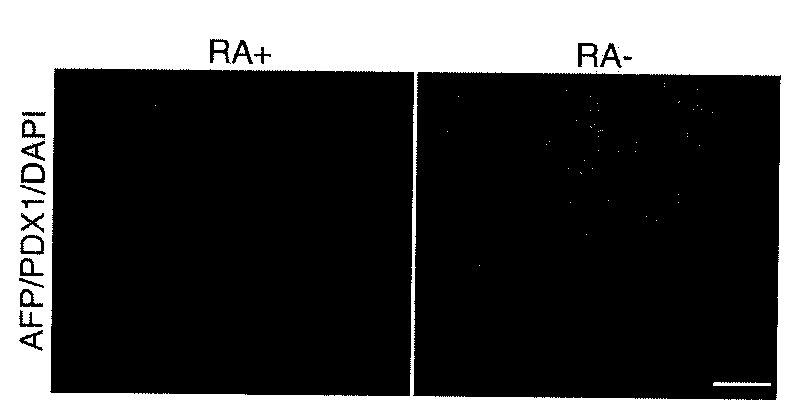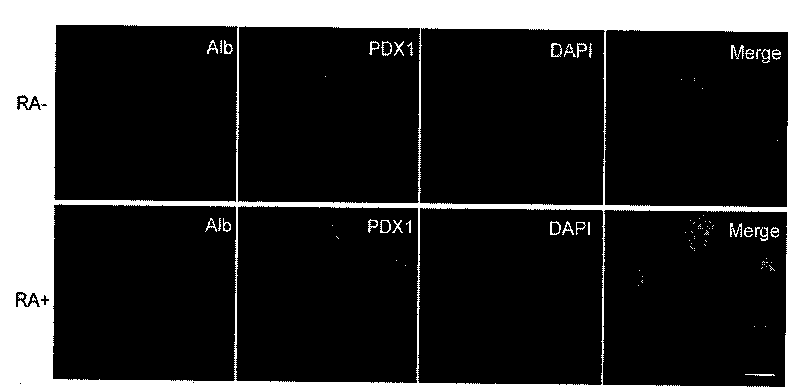PDX1 positive entoderm cell and preparation method thereof
A technology of endoderm cells and embryonic stem cells, which is applied in the field of PDX1-positive endoderm cells and their preparation, can solve the problem of low efficiency of human embryonic stem cell differentiation, and achieve the effect of strong operability, broad application prospects, simple and fast operation
- Summary
- Abstract
- Description
- Claims
- Application Information
AI Technical Summary
Problems solved by technology
Method used
Image
Examples
Embodiment 1
[0091] Embodiment 1, the separation of mouse embryonic fibroblast (MEF)
[0093] 1) After purchasing Matrigel, it must be subpackaged first to avoid repeated freezing and thawing processes each time it is used. Thaw the entire bottle of Matrigel on ice at 4 overnight;
[0094] 2) After it is completely melted, put it on ice, divide it with a cold pipette tip, and put equal volumes into sterile 1.5ml ice-bathed centrifuge tubes according to the needs of use, and then store it at -80 degrees refrigerator;
[0095] 3) Take out the centrifuge tube from the refrigerator every time you use it, and insert it on ice;
[0096] 4) Add a certain volume of cold DMEM / F12 medium, blow and suck repeatedly on ice with a pipette tip to melt Matrigel and dilute it in the medium, or let Matrigel melt on ice and then add cold DMEM / F12 for culture The base blows and sucks evenly;
[0097] 5) Add the diluted Matrigel to the culture dish or culture well, and add c...
Embodiment 2
[0126] Example 2. Embryonic stem cells were induced to differentiate into PDX1-positive endoderm cells
[0127] The embryonic stem cells used in this example are the human embryonic stem cell line H1.
[0128] 1. Preparation method
[0129] (1) Embryonic stem cells are induced to differentiate into endoderm cells, which do not express the transcription factor PDX1:
[0130] 1. Take out the differentiation medium from the refrigerator and preheat it in a 37°C water bath;
[0131] 2. On the third day after the passage of embryonic stem cells, take out the cells, suck off the medium, and wash with PBS;
[0132] 3. Add endoderm cell culture medium containing 100ng / ml Activin A to the culture dish, the volume is 3ml / 6cm culture dish. Then put back in 5% CO 2 in the cell culture incubator;
[0133] 4. After 24 hours, take out the cells from the incubator, suck off the medium, add endoderm medium containing 100ng / ml ActivinA and 0.1% ITS, the volume is 3ml / 6cm culture dish;
[...
Embodiment 3
[0171] Example 3. Embryonic stem cells were induced to differentiate into PDX1-positive endoderm cells
[0172] The embryonic stem cells used in this example are the human embryonic stem cell line H1.
[0173] 1. Preparation
[0174] The method is the same as that described in the treatment group with RA added in Example 2, except that RA is added for induction, except that in the step of "inducing endoderm cells that do not express the transcription factor PDX1 to differentiate into PDX1-positive endoderm cells" , the cell seeding density is different, as follows: The first group: 2×10 3 Cells / cm2; the second group: 5×10 3 cells / cm2; the third group: 2×10 4 Cells / cm2; the fourth group: 5×10 4 cells / cm2; the fifth group: 2×10 5 Cells / cm2; varying concentrations of all-trans retinoic acid (RA), 0.4 uM in precursor cell differentiation medium.
[0175] 2. Cell detection
[0176] The method is the same as the cell immunofluorescence staining method described in Example 2. ...
PUM
 Login to View More
Login to View More Abstract
Description
Claims
Application Information
 Login to View More
Login to View More - R&D
- Intellectual Property
- Life Sciences
- Materials
- Tech Scout
- Unparalleled Data Quality
- Higher Quality Content
- 60% Fewer Hallucinations
Browse by: Latest US Patents, China's latest patents, Technical Efficacy Thesaurus, Application Domain, Technology Topic, Popular Technical Reports.
© 2025 PatSnap. All rights reserved.Legal|Privacy policy|Modern Slavery Act Transparency Statement|Sitemap|About US| Contact US: help@patsnap.com



